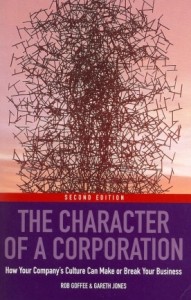- Despite its ability to make or break a business, corporate culture remains the most underutilised resource in business.
- The notoriously amorphous concept of culture can in fact be distilled into a diagnostic test that managers can use to determine:
- How the ways in which people relate to each other affects the company’s performance, as well as the individual’s quality of life
- Why most organisations are characterised by several cultures at once
- How to change an organisation from one culture to another
- Every modern business force is pushing companies towards disintegration: globalisation, IT, downsizing and delayering, and mass customisation.
- Culture is made up of common values, symbols, beliefs, and behaviour.
- The Double S cube maps solidarity against sociability to generate four types of company (it is 3D so each can be positive or negative):
- High social, high solid = Communal
- High social, low solid = Networked
- Low social, high solid =Mercenary
- Low social, low solid = Fragmented
- Companies can slide (unintentionally) into the negative form of the culture but can only climb out of it.
WHAT’S GOOD ABOUT IT
- There are four sets of test questions companies can enact:
- 1. Observational Checklist (physical space, communication, time, identity)
- 2. Corporate character questionnaire (23 of them)
- 3. Is the culture positive or negative? (a series of cross checks)
- 4. Critical incident analysis (a series of scenarios, and answer analysis)
- These allow you to classify your company and work out what to do.
- Each of the four company types is then analysed to explain the rules of survival in them, the message they send out, their pros and cons, how leadership works in them, and how to thrive in them.
- Change is not always a choice, and can lead to dysfunction. There are a series of symptoms to look out for and steps to rectify them
- To increase sociability: promote idea sharing, increase interaction opportunities, design conducive architecture, increase informality
- To unpick solidarity: introduce qualitative measures and break up cliques
- To determine your role, ask ethical, personal questions: what are prepared to do in the name of the organisation, how close do you want to get to people?
WHAT YOU HAVE TO WATCH
- It first came out in 1998 so is a bit out of date, even in 2003 second edition.

